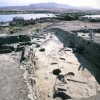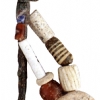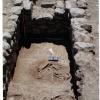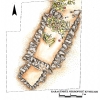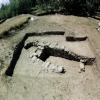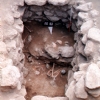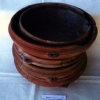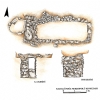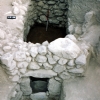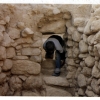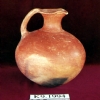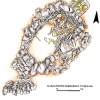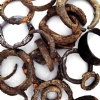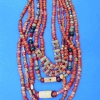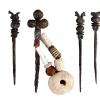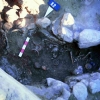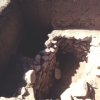Mound of Karagündüz and Necropolis, located 34 km northeast of the city of Van and 6 km north of Erçek, on the western shores of Lake Erçek. The excavations conducted during the period 1993-1999 under the direction of Prof.Veli Sevin yielded settlement and strata from the Early Bronze Age until the Middle Ages. The Urartian architecture built with stone-based mudbrick walls consists of a group of buildings consisting of several rooms.
The necropolis area is approximately 1.5 km northeast of the mound. There are three types of tombs in the necropolis area. Dromos graves, and without dromos samples and earth graves. In this respect, it shows the same characteristics as other necropolis areas in the region. The burial chambers built into the underground pits with stone masonry walls and the thrusting technique again show multiple burials.
The burial chambers are reached by a well-shaped passage (dromos) formed by stone or main soil from the soil surface. The door of the grave chamber is generally covered with a flat stone. The grave chamber, which is reached from the low gate passage, is generally rectangular. The side walls are overlapping and make it easier to form the top cover by shrinking towards the ceiling. The top cover is formed by placing a false belt or flat slab stones.
Its presence in the burial chamber gives important information about Urartian rural culture and burial customs. The dead were deposited in the hoker position (knees at the abdomen slant) and the food and drinks were placed inside, as well as iron and bronze jewelry and weapons. Some graves have over 100 burials. In order to create space for the new burials, it was observed that the old burials were gathered together with the burial gifts to the bottom of the burial chamber. In these areas, it turns into a kind of waste area formed by human remains and burial gifts. In some graves, it is seen that new burial areas were created / opened in the burial chamber. It is also buried in caverns and small units, which can be passed through the side walls and opened to the main soil. In some graves, the skulls were collected in the same area or placed in the bowls. For example, 10 skulls were found in a section that can be reached from an opening in the middle of the northeastern short wall of the K10 burial chamber, accessible only by hand.
It is not understood that this situation, which is not observed in all graves, whether is an application in the context of burial customs or not.
In the Karagündüz chamber tombs, cremation (cremation) can be seen by incinerating the normal burials. In other words, two different burial traditions can be applied in the same burial chamber.
The most common burial gifts in the tombs are pottery, bracelets made of iron, rings, earrings, ornamental pins, knives and daggers made of iron and bead necklaces.
Simple soil graves were also found in the Karagündüz Necropolis. In the grave containing two children burials, a red-lined Urartian pottery and a bronze ornament needle was found.
